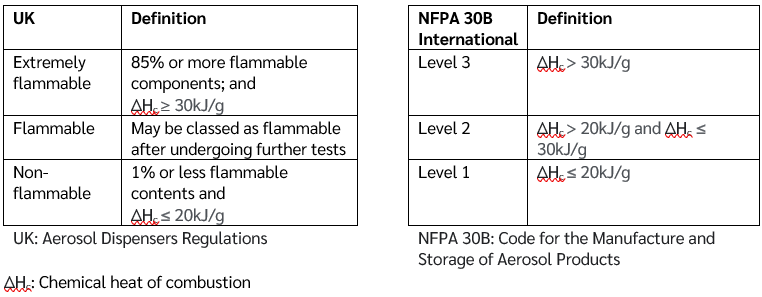Aerosols are a familiar sight in our daily lives, providing the easy application of deodorant, cleaning materials, paint or other products in our home or workplace. However, aerosols can also contain flammable substances as well as pressurized flammable propellants, such as propane or butane which can easily ignite and lead to rapid fire spread. In a fire, containers can rupture, producing jets of flame and projectiles, spreading the fire, and making firefighting more difficult. The smoke from the resulting fire can pose additional health risks. Robust property loss controls are therefore needed to manage the storage and handling of aerosols.

Understanding the risk
Not all aerosols are the same. Lower-hazard aerosols can include water-based toiletries such as shaving foam or carpet shampoo. Water-miscible flammable liquids such as hairspray or windscreen de-icer present a higher hazard. The highest hazard category includes insoluble flammable and combustible liquids, such as spray paints and vehicle engine cleaning products.
The hazard and flammability classification of aerosols can depend on the country and code being used. Two example classification systems are provided below:


Mitigating the risk of aerosols
The assessment of property risk and associated control measures will depend on factors such as the aerosol classification, the location and quantity stored. Several considerations are provided below when storing aerosols in bulk within commercial and industrial situations:
Risk assessment: Conduct a formal risk assessment and review and update existing controls in accordance with local fire safety legislation such as the Regulatory Reform (Fire Safety) Order 2005, Dangerous Substances and Explosive Atmospheres Regulations 2002 (DSEAR) and, where larger quantities are stored, major hazards legislation such as the Control of Major Accident Hazards (COMAH) Regulations and Planning (Hazardous Substances) Regulations.
Property protection and business resilience: Reinforce the risk assessment by considering property protection and business resilience features, such as fire divisions and fire protection systems. These will help to keep losses small and accelerate business recovery. Liaise with your broker and property risk engineering provider for more information.
Storage: Carefully consider the storage of aerosols to limit the likelihood and severity of an aerosol fire. Where aerosols are stored in bulk, segregate and isolate storage, ideally in a separate building in a cool and ventilated area to prevent the build-up of flammable vapors. Where this is not possible, store the aerosols in a dedicated fire compartment or enclosed within stout steel mesh cages of limited size and with self-closing doors. Smaller quantities should be stored in a dedicated container such as a metal gas cylinder storage cabinet. Avoid accidental damage of aerosols and have a process to manage containers should damage occur.
Ignition sources: Identify potential ignition sources, ensure they are well-controlled and away from aerosols. This includes managing activities on site such as hot work, electrical equipment, sources of heat and smoking as well as other sources such as arson, exposure to external fires and lightning. The movement and charging of forklift trucks (or similar) is a common potential source of ignition and such equipment should be suitably specified and managed for the aerosol hazards.
Management systems: Ensure appropriate management systems are in place including training of personnel, housekeeping (avoiding the build-up of combustible materials or packaging) and emergency procedures.
Fire detection and protection: Install appropriate fire protection systems. Sprinklers can help prevent a fire spreading to involve aerosols and potentially limit a fire involving aerosols. Other considerations include fire detection, alarms, extinguishers, and fire water for manual firefighting.
Emergency and incident response: Develop and practice emergency plans to help contain and suppress the fire (where appropriate) and evacuate personnel from the area. Ensure good access and information is available for the responding fire brigade. Following any incident, conduct a thorough investigation to identify any control failures and implement corrective actions.
Education and training: Regularly train staff of the dangers of aerosols including handling, storage and emergency and incident response procedures. Clear signage should indicate where aerosols are stored and their associated risks.
For more information to assess and manage the handling and storage of aerosol, utilize the relevant recognized guidance. Examples include: RC19: Recommendations for the storage of aerosol products. 2015. Fire Protection Association https://www.thefpa.co.uk/resource-download/327 (opens a new window) NFPA 30B: Code for the Manufacture and Storage of Aerosol Products. 2023. National Fire Protection Association. https://www.nfpa.org/for-professionals/codes-and-standards/list-of-codes-and-standards/free-access (opens a new window) Property Loss Prevention Data Sheets 7-31. Interim Revision July 2024. FM Global. https://www.fm.com/resources/fm-data-sheets (opens a new window) |

